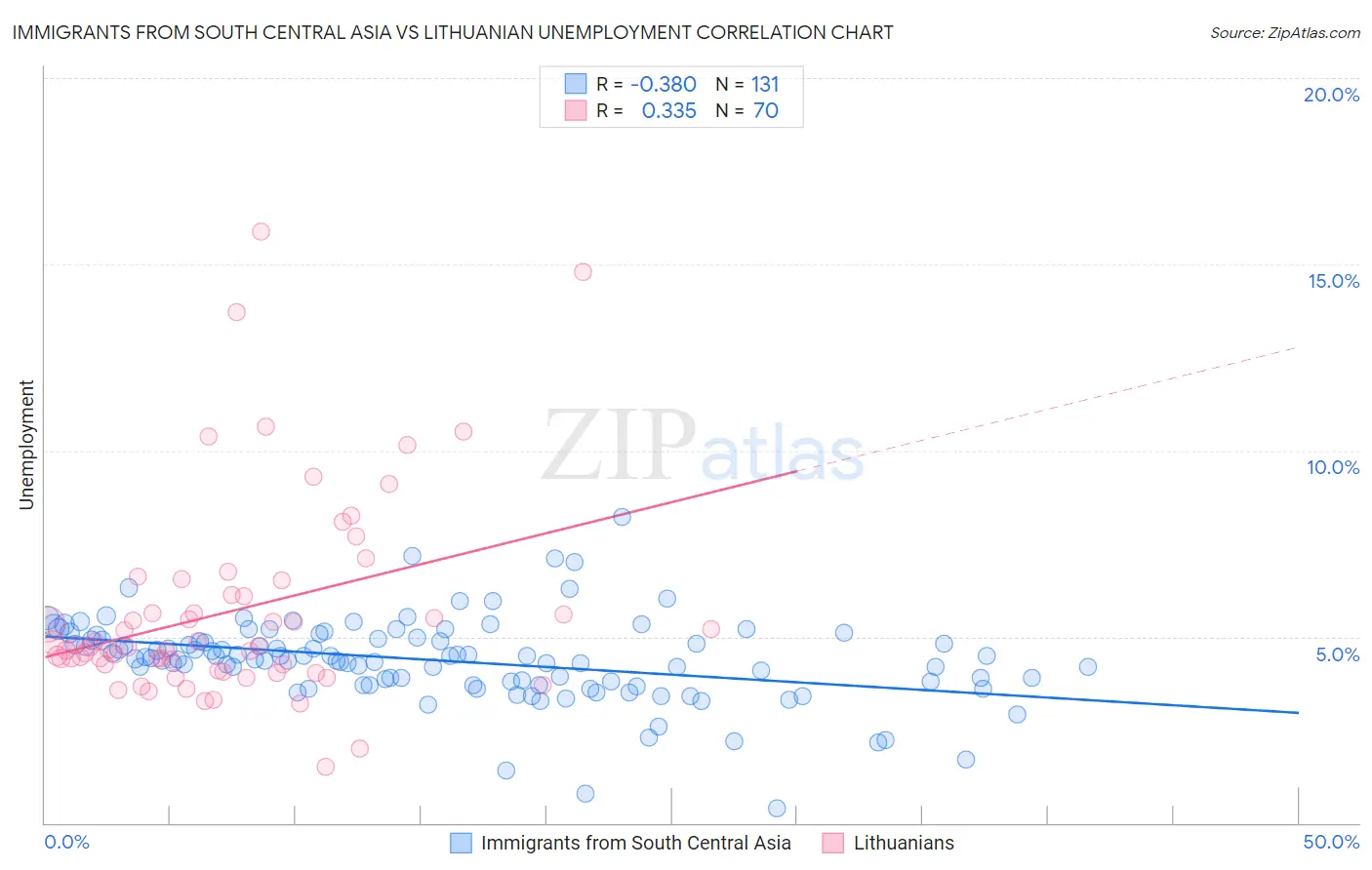Immigrants from South Central Asia vs Lithuanian Unemployment
COMPARE
Immigrants from South Central Asia
Lithuanian
Unemployment
Unemployment Comparison
Immigrants from South Central Asia
Lithuanians
4.9%
UNEMPLOYMENT
99.3/ 100
METRIC RATING
49th/ 347
METRIC RANK
4.8%
UNEMPLOYMENT
99.7/ 100
METRIC RATING
39th/ 347
METRIC RANK
Immigrants from South Central Asia vs Lithuanian Unemployment Correlation Chart
The statistical analysis conducted on geographies consisting of 472,428,090 people shows a mild negative correlation between the proportion of Immigrants from South Central Asia and unemployment in the United States with a correlation coefficient (R) of -0.380 and weighted average of 4.9%. Similarly, the statistical analysis conducted on geographies consisting of 421,273,270 people shows a mild positive correlation between the proportion of Lithuanians and unemployment in the United States with a correlation coefficient (R) of 0.335 and weighted average of 4.8%, a difference of 1.2%.

Unemployment Correlation Summary
| Measurement | Immigrants from South Central Asia | Lithuanian |
| Minimum | 0.40% | 1.5% |
| Maximum | 8.2% | 15.9% |
| Range | 7.8% | 14.4% |
| Mean | 4.4% | 5.7% |
| Median | 4.4% | 4.7% |
| Interquartile 25% (IQ1) | 3.8% | 4.3% |
| Interquartile 75% (IQ3) | 4.9% | 6.1% |
| Interquartile Range (IQR) | 1.2% | 1.9% |
| Standard Deviation (Sample) | 1.1% | 2.7% |
| Standard Deviation (Population) | 1.1% | 2.7% |
Demographics Similar to Immigrants from South Central Asia and Lithuanians by Unemployment
In terms of unemployment, the demographic groups most similar to Immigrants from South Central Asia are Immigrants from Scotland (4.9%, a difference of 0.010%), French Canadian (4.9%, a difference of 0.020%), Immigrants from Belgium (4.9%, a difference of 0.18%), White/Caucasian (4.9%, a difference of 0.19%), and Immigrants from Taiwan (4.8%, a difference of 0.22%). Similarly, the demographic groups most similar to Lithuanians are Northern European (4.8%, a difference of 0.020%), Immigrants from Bosnia and Herzegovina (4.8%, a difference of 0.040%), Bolivian (4.8%, a difference of 0.14%), Czechoslovakian (4.8%, a difference of 0.34%), and Tongan (4.8%, a difference of 0.41%).
| Demographics | Rating | Rank | Unemployment |
| Immigrants | Bolivia | 99.8 /100 | #34 | Exceptional 4.8% |
| Scotch-Irish | 99.8 /100 | #35 | Exceptional 4.8% |
| Tongans | 99.7 /100 | #36 | Exceptional 4.8% |
| Czechoslovakians | 99.7 /100 | #37 | Exceptional 4.8% |
| Bolivians | 99.7 /100 | #38 | Exceptional 4.8% |
| Lithuanians | 99.7 /100 | #39 | Exceptional 4.8% |
| Northern Europeans | 99.7 /100 | #40 | Exceptional 4.8% |
| Immigrants | Bosnia and Herzegovina | 99.7 /100 | #41 | Exceptional 4.8% |
| Filipinos | 99.5 /100 | #42 | Exceptional 4.8% |
| Yugoslavians | 99.5 /100 | #43 | Exceptional 4.8% |
| Austrians | 99.5 /100 | #44 | Exceptional 4.8% |
| French | 99.5 /100 | #45 | Exceptional 4.8% |
| Immigrants | Nepal | 99.4 /100 | #46 | Exceptional 4.8% |
| Immigrants | Taiwan | 99.4 /100 | #47 | Exceptional 4.8% |
| Immigrants | Scotland | 99.3 /100 | #48 | Exceptional 4.9% |
| Immigrants | South Central Asia | 99.3 /100 | #49 | Exceptional 4.9% |
| French Canadians | 99.3 /100 | #50 | Exceptional 4.9% |
| Immigrants | Belgium | 99.2 /100 | #51 | Exceptional 4.9% |
| Whites/Caucasians | 99.2 /100 | #52 | Exceptional 4.9% |
| Immigrants | Zimbabwe | 99.2 /100 | #53 | Exceptional 4.9% |
| Eastern Europeans | 99.2 /100 | #54 | Exceptional 4.9% |